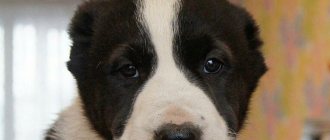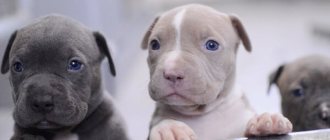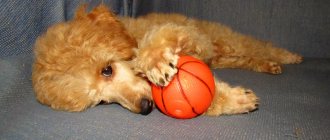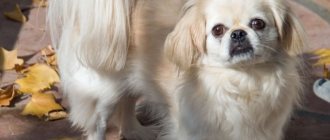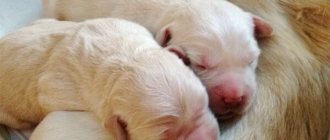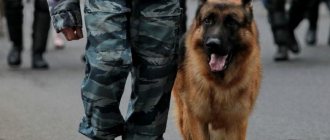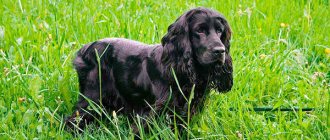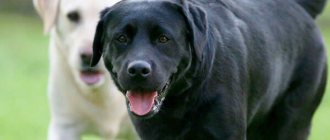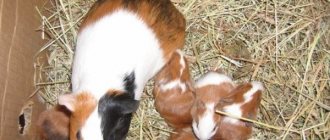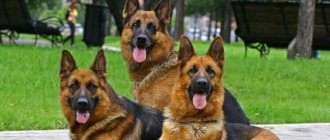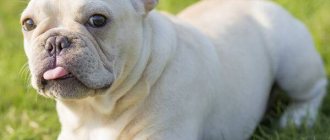From childhood, Pekingese puppies are calm, phlegmatic and stubborn.
These small dogs are often capricious and disobedient, but at the same time they are well aware of the owner’s mood and know how to adapt to it.
Since childhood, such a dog is quite self-sufficient; he will never impose himself or fulfill demands that he does not like.
Pekingese puppies are difficult to train and can only master the simplest commands.
Photos of newborn puppies
The neonatal period for Pekingese puppies lasts approximately 12 days.
Immediately after birth, babies are completely helpless and are unable to see, hear, or empty their bowels and bladder. A newborn is only able to respond to smell, temperature and touch. In addition, it does not have thermoregulation and is heated by the mother. Babies' eyes open 12-15 days after birth.
The weight of a newborn is 150-250 g, height 15-20 cm. However, the size of the babies may vary depending on how many puppies the bitch gives birth to.
Coat type and color
So, the standard states that excessive fluffiness is a fault. How to determine the norms? Pekingese are required to have a full mane, but it should not go beyond the shoulder line. Rich feathering on the paws, ears and tail should decorate the dog, but not hide its silhouette and certainly not impede movement. The other extreme is the so-called short-haired Pekingese. This type of breed does not exist, despite the abundance of “special” puppies for sale. If you are offered to buy a short-haired Pekingese, you are dealing with:
- Marriage – insufficient coat.
- A groomed dog.
- Mixed with Japanese Chin.
- Not a purebred dog, in other words, a miniature mongrel.
Development from 1 to 12 months
| Pet age | Size | Weight | Description |
| 1 month | 15-20 cm in length | At the end of the period - weight 500-700 g. | In the first month of life, the puppy feeds on its mother's milk. Starting from 3 weeks of age, the dog already shows interest in solid food. A Starting from 14 days, his eyes and ears come off, and his intestines begin to work independently. |
| 2 months | 25-35 cm in length | 800-1100g | The baby masters the principles of social behavior, he has already developed all physiological functions, and he also completely switches to solid food. In the middle of the 2nd month, the puppy is gradually weaned from its mother. |
| 3-4 months | 8-10 cm at the withers | 1.2-2 kg | The baby's teeth begin to change, and signs of character also appear. At this age, the pet awakens to its individuality. |
| 4-6 months | 10-12 cm at the withers | 2-5 kg | The dog gains significant height and weight, and also begins to show interest in the opposite sex. |
| 7-9 months | 12-15 cm at the withers | 3-6 kg | Now this is a teenage dog, the pet’s character and habits have already been practically formed, and active hormonal changes associated with puberty begin in the body. |
| 10-12 months | 15-25 cm at the withers | 5-7 kg | At this age, females begin their first heats, and males become more active, marking their territory and trying to take a higher place in the hierarchy. |
Appearance
Looking through exhibition photos of Pekingese, we see noble dogs with luxurious fur and an imperturbable appearance. Against the background of standards, there is a huge number of dogs called purebred, but which do not meet the breed standard for a number of requirements. By the will of fashion and the efforts of breeders and businessmen, Pekingese have been “degenerating” for decades, which has led to a wide range of health problems and a serious risk of detecting defects in high-quality litters.
Representatives of the breed are typically undaunted, reserved, friendly, proud and arrogant, without a trace of cowardice or aggression. When assessing the standard, the obvious conclusion is that judges have a fairly large “buffer” for their own judgments. The dog should not be too bony or fluffy. In appearance, the Pekingese resembles a small lion with a well-balanced body. Perhaps one of the points that has a clear framework is the free breathing and unfettered movements of a dog of any structure, size, type of bone structure and coat.
Sexual dimorphism of the breed is weakly expressed despite the fact that females are larger than males. The Pekingese is also characterized by a deceptive appearance; the short-legged and miniature pet turns out to be surprisingly heavy and knocked down. The height of dogs is not specified by the standard and usually varies between 12–23 cm, weight is indicated at the maximum value:
- Male – 5 kg.
- Female – 5.4 kg.
Basic care rules
Rules for caring for a Pekingese puppy include:
- Brushing with the help of special brushes and combs; you need to comb your baby daily to avoid the appearance of tangles.
- Daily walks for 30-40 minutes 3 times a day.
- The puppy is bathed as needed using a special shampoo and conditioner for coarse coats.
- You can cut your pet's hair starting from 6 months of age. Approximately once every 2 months, cosmetic haircuts should be performed, paying special attention to the paw pads and the space between the toes.
- Eye care must be performed with special care due to their structure. The Pekingese's eyes have a shortened tear duct, so they are susceptible to inflammation and injury, which means that they need to be wiped daily with a cotton pad and a special solution. Also, the puppy's eyes should be examined daily for inflammation of the tear ducts.
- Nails are trimmed once every 2 weeks using a special nail clipper.
- Regular examination by a veterinarian (at least every six months) is an integral part of good care.
- Timely vaccination according to schedule.
- Carrying out deworming and antiparasitic treatment.
Characteristics table
The table below shows the main characteristics of the breed.
| Characteristic | Level (on a 5-point scale) |
| Aggressiveness | 3 (average) |
| Activity | 2 (low) |
| Training | 2 (problematic) |
| Shedding | 3 (average) |
| Care | 5 (high maintenance) |
| Friendliness | 3 (average) |
| Health | 2 (there are often problems) |
| Maintenance cost | 2 (low) |
| Attitude towards loneliness | 3 (normal) |
| Intelligence | 3 (normal) |
| Noisiness | 3 (average) |
| Security | 4 (good) |
How to toilet train?
Given the innate stubbornness of the Pekingese, babies should be toilet trained exclusively through interest and encouragement. In the beginning, you should use a diaper or tray with filler.
From the first days of your dog's stay in the house, you should show him the place where he needs to defecate. At the initial stage, you can use several diapers or trays and place them in those places where the puppy most often does his business. He should have a clear association with the litter box and emptying. After a while he himself will look for it.
The second stage is toilet training outside. You can do this from the very first walks. To do this, you need to walk with the baby until he goes to the toilet, and then praise him and treat him with a treat. The goal is to reinforce in the dog’s mind that defecating on the street is associated with positive emotions.
NOTE!
When training a Pekingese, you should not use a punishment system; these dogs simply will not understand this approach and the result will be the opposite.
Character of this breed
The Pekingese is an aristocratic animal, this is strongly visible in its character. He looks at his owner with some condescension, is in no hurry and does not like too harsh sounds. At the same time, he likes a calm environment where he is loved, but not too distracted from his important matters. The Pekingese is a rather selfish dog that requires love and care, but really does not like to be told off. She is inclined to harbor a grudge, and then can take revenge on the owner if he somehow treated her wrong. For example, he poked his nose into waste products that were outside the designated area. With this approach, the Pekingese will never do what the owner wants, but will definitely find a way to take revenge on him.
Unpleasant manipulations such as shouting, direct commands and attempts to evoke conscience will not work. The Pekingese will only do what it wants to do. That is why they need to be “commanded” with flattery. Otherwise, they will remember that they are descendants of a lion and will defend what they believe in to the bitter end. But don’t assume that this dog is a selfish hermit. She is a very loyal friend who loves to spend time with her owner. It's just a matter of mood. This is quite a positive point, since they can be safely left alone, they will not whine in longing for their owner, putting all the neighbors on their ears.
The animal has a certain line of empathy, and builds it with the owner. This line remains until the end of life. Therefore, the Pekingese will feel very well any emotional changes that the owner has. But at the same time, the Pekingese does not provide strong moral support, and does not come to be petted on the lap. If this happens, then you should think about the fact that you were sold not a purebred, but a mixed-breed Pekingese. Because the purebred Pekingese is very proud, and does not often come to people for such purposes.
It is worth repeating that the Pekingese is very selfish, and he does not tolerate love for other animals, which takes away the love of the owner from him. He does not conflict with other pets, as he considers this beneath his dignity, but he treats them with some contempt, and does not make too many friends with them, demarcating his territory. This is how he shows where his personal territory begins, which should not be penetrated. Sometimes he can provoke other animals by pretending that they started it. But, in general, again, the Pekingese does not seek to develop conflicts, largely because it assesses its own capabilities well in comparison with other animals.
This breed tolerates pain very poorly and does not like to endure it. For this reason, he is not very friendly towards children and tries to avoid them. He also doesn't like noise, and for this reason again avoids children. He is selfish, and prefers those who do not try to force him to strictly obey. The Pekingese can follow orders, but not directly, but rather based on flattery. He doesn't like a lot of physical contact, so you should be very careful when hugging your Pekingese.
The Pekingese dog is a little different from the dog world. This dog is very cold towards strangers, for example, towards children, whom the Pekingese does not like. For his owner, he will show love and even ingratiation towards him, but without doing too much. He recognizes affection for his master, but without great motives. Pekingese are not very obedient, but they are brave and loyal and can be a bit reckless.
If you tame it, it is a great pet and very friendly. His teachers are mostly single people, older people or couples without children who don't want to be out too long, which suits him just fine.
What to feed for the first 3 months?
In the first 3 months, the baby should be fed only natural food, which should include:
- Boiled lean meat minced in a meat grinder.
- Boiled eggs.
- Fresh or stewed vegetables that do not cause bloating (beets, carrots, zucchini, cucumber, etc.).
- Fermented milk products (kefir, yogurt, yogurt, cottage cheese).
- Lean sea fish without bones.
- Oatmeal, buckwheat or rice porridge.
Home maintenance
Keeping a Pekingese at home is not difficult, which is why they are so popular. It is easy to create a comfortable environment for such a dog; it does not require anything special. The only thing the owner will need to provide is two half-hour walks every day. Pekingese are very active - movement is literally vital for them.
Training
Significant difficulties may arise with training due to the animal’s excessive stubbornness. Many representatives of this breed cannot be trained to use a leash. Education and training in this case will require a lot of patience from the owners. One of the positive aspects is that training does not require any special platforms or devices. It is quite possible at home.
Keeping a Pekingese at home is not difficult, which is why they are so popular
You need to start learning from an early age. It is very important to repeat the skills daily until they are fully mastered. This will help secure them securely, bringing them to automaticity. If the puppy shows excessive stubbornness and does not respond to the owner’s commands, it is recommended to send it to a dog handler for training.
Care and hygiene
Although Pekingese are quite unpretentious, unprepared owners may have some difficulties.
These dogs very quickly get used to the rules established by the owner, trying to follow the usual routine. Many will see the advantage in the fact that it is quite possible to train such a dog to a litter tray. This is undoubtedly useful, but does not mean that it will save the owner from daily long walks with the pet.
After walking outside in the warm season, you need to carefully check your pet for ticks. And also constantly monitor for the presence of fleas, which the puppy can pick up after contact with other animals. If fleas do appear, veterinarians recommend the drug Frontline, which is sold in the form of a spray or drops.
Hygiene recommendations:
They very quickly get used to the rules established by the owner, trying to follow the usual routine.
- The pet is taught hygiene from puppyhood. During events, it is important to constantly maintain contact with the animal, talk to it, and encourage it.
- First, decide on the place that you will allocate for the toilet for the animal. Tray training may take several months. Be patient and remember that rudeness will not help in learning, but, on the contrary, will worsen the result.
- All hygiene procedures must be carried out at the same time, otherwise the dog will perceive it as something bad and will begin to avoid them.
- In addition to the toilet, the pet should have a personal space - a secluded corner where he can rest. It is better to place a special bed there for sleeping.
- The animal is not bathed often. If necessary, you can use dry shampoos. All hygiene products must be purchased from pet stores or veterinary pharmacies; use of drugs for humans is not allowed.
Behind the ears
Your pet's ears should be examined every day. It is advisable to regularly wipe them with a cotton swab, like the fold of the nose, to avoid the accumulation of secretions and sweat. If there is an unpleasant odor coming from your pet's ears, you should contact your veterinarian immediately.
Behind the wool
Gorgeous coat is the main advantage of this breed. Accustoming your pet to hygiene begins with brushing. The puppy is brushed daily, calming and encouraging. Many owners groom their Pekingese not only to achieve the desired appearance, but for hygienic reasons.
Behind the teeth
To ensure that the replacement of baby teeth goes smoothly, it is recommended to regularly consult a veterinarian. It would also be a good idea to purchase a special bone that your baby can chew on.
Gorgeous coat is the main advantage of this breed.
Behind the claws
Pekingese claws are very sharp, the puppy can be injured. In addition, they grow quite quickly - if you miss the time and do not trim them on time, they will grow into the pads of the paws. The dog will experience torment, and to correct the situation, you will have to resort to surgery. Nails must be trimmed at least once a month with nail clippers. If necessary, the procedure is carried out more often, but only with the approval of the veterinarian.
How to feed?
A 2-month-old puppy is usually fed 6 small meals a day.
At 3-4 months old, a baby can already eat 4-5 times a day, with portions being slightly increased.
From 5 to 9 months the pet is fed 3 meals a day.
And from 10 months he is fed 2 times a day, morning and evening.
Menu for the week
Monday:
- Breakfast – oatmeal with liver.
- Lunch – boiled beef.
- Dinner - cottage cheese.
Tuesday:
- Breakfast - curdled milk.
- Lunch – rice porridge with heart.
- Dinner - stewed zucchini and a piece of fish.
Wednesday:
- Breakfast - boiled egg.
- Lunch – heart or liver with buckwheat.
- Dinner – baked pumpkin with rice.
Thursday:
- Breakfast - yogurt.
- Lunch – veal with fresh carrots.
- Dinner – rice porridge with stewed beets.
Friday:
- Breakfast – boiled carrots with a piece of fish.
- Lunch – buckwheat porridge with heart or tripe.
- Dinner – cottage cheese or kefir.
Saturday:
- Breakfast – veal with fresh cucumber.
- Lunch – oatmeal with yogurt.
- Dinner – stewed zucchini.
Sunday:
- Breakfast - cottage cheese or yogurt.
- Lunch – beef tripe with rice porridge.
- Dinner – baked pumpkin.
Pekingese breed standard
In the 60s, when they were first brought to England, they were in many ways reminiscent of Japanese Chins, but over time the external difference became very noticeable. They began to weigh much more, their paws became shorter, and other differences appeared that made it possible to distinguish this breed from many others. To many people they resemble lions in appearance. You can always distinguish the Pekingese by its specific muzzle, which gives the impression that it is somewhat flattened. The Pekingese has slightly bulging eyes that resemble beads. A small, extremely neat tongue with a slight degree of roughness.
Now you can find two varieties of the breed: “sleeve” and standard. Unlike the standard one, the second version of the breed is more miniature in size and easily fits into the owner’s bag. As adults, they gain no more than 3 kg of mass. Females of this variant of the breed are not bred, since due to such a low weight they simply will not be able to bear future offspring.
Head
The Pekingese's skull is quite heavy, with flattened ears and clearly defined. Dogs of this breed have a short muzzle, noticeably stretched in width.
Mouth
The mouth is small in size, containing two rows of small but very sharp teeth. The teeth are always hidden behind thick lips.
Nose
The Pekingese has a rather funny nose, it is very wide and seems to be flattened. The lobe is distinguished by a rich black shade with some pigments. The dog's nostrils are wide.
Eyes
They are often very convex, so they require special care and handling (the dog should not be hit on the head). They are most often dark in color. Dogs of this breed with light eyes are extremely rare and are rather exceptions.
Ears
They are characterized by a high seating position and are often shaped like a heart. The fur on the ears is pleasant to the touch, very soft.
Neck
This breed has a small but very massive neck.
Body
In terms of size, the Pekingese is a small dog. The part in front is always more massive than the back, while the waist is clearly visible.
Paws
The paws of this breed are massive and very short; this is largely an individual feature of these dogs. The nails are quite long and require careful handling, otherwise the dog can damage the blood vessels. Bones have good strength, but still require careful handling, otherwise fractures may occur. The Pekingese is a passive dog; it walks slowly and majestically.
Tail
It is characterized by a high seating position and is slightly curved at the end. The tail is fluffy and extremely pleasant to the touch. The coat is approximately the same as that on the main part of the body, so it requires careful grooming.
Wool
This breed is very popular for its fur. It is soft, thick, long and pleasant. There is a lot of fur on the body, neck and tail. This coat needs careful care, at least twice a week, otherwise tangles and other troubles will form that will negatively affect the dog’s appearance and health.
Color
Nowadays you can find Pekingese in completely different shades, except for some shades of brown. Also, it is not normal to have an albino Pekingese.
Vaccination schedule
The first vaccinations for puppies are usually given by the breeder, and the rest should be taken care of by the new pet owner.
| Pet age | Vaccination |
| 2 months | The pet is vaccinated against leptospirosis, distemper, hepatitis, adenovirus infection, parvovirus enteritis, and proto-influenza. |
| 3 months | Revaccination against the same diseases. |
| 6 months | Rabies vaccine is administered. |
| 12 months | Vaccinations are repeated. |
| Annually | The dog receives the same set of vaccinations throughout its life. |
Safety precautions
If a shepherd puppy grows up in a city apartment, a number of rules must be followed to protect it from injury. There are almost no differences here from other puppies or even small children:
- Wires should be hidden in special boxes or plinths.
- Strengthen or remove unstable furniture.
- Don't let him play with small, fragile toys: he will definitely break them and swallow the fragments.
- Anything that lies within his reach will be stolen and turned into a toy, so things must be put away in cabinets and drawers.
- To prevent the puppy from sharpening its teeth on all surrounding objects, it must have its own training equipment. They are sold in abundance in veterinary pharmacies - these are bones from ox veins, and scraps of rope, and cast heavy balls. You need to bring home 2-3 toys, and he will choose his favorite one.
- There should be a carpet or other similar covering on a slippery floor: the puppy’s weak paws are easily injured on a slippery floor.
- If there are children in the house, they need to be instructed how to properly handle the dog. The main thing is not to allow him to be picked up: even at three months he is quite heavy, up to 10 kg, and his paws are weak, they can easily be injured if he is accidentally dropped.
Hygiene procedures
It is recommended to bathe a Pekingese puppy from 6 months of age and only if the dirt is too strong. If this is not the case, then it is better to manage with dry shampoo and combing.
But if your pet still needs to be bathed, then the following rules should be followed:
- The water for bathing should be approximately 38-39 degrees, and its amount should reach the puppy approximately to the knee, so as not to cause fear.
- The room should be warm and there should be no drafts.
- When bathing, it is advisable to use shampoo designed specifically for puppies of long-haired breeds.
- After bathing, the baby is wrapped in a soft towel, dried thoroughly, and then dried with a hairdryer.
- You cannot walk with your baby for 3 hours in the swimming area, and you should also protect him from drafts.
In addition to bathing, caring for Pekingese puppies includes:
- Weekly brushing of teeth using a specially designed dog brush and toothpaste.
- Inspect the ears daily for dirt and inflammation, as well as weekly cleaning with a dry cotton swab.
- Nails are trimmed once every 2-3 weeks using a special nail clipper.
- Hair combing is done daily using special brushes and combs.
Interesting Facts
The following interesting facts are known about the Pekingese:
- An ancient legend says that this breed is a descendant of a lion and a monkey. Therefore, the Pekingese is very proud and has a remarkable appearance, which is very reminiscent of a lion;
- the Pekingese has a short muzzle and does not tolerate the hot season very well, requiring special care measures;
- they actively dream, so they often make a variety of sounds in their sleep, which to many resemble snoring or snoring;
- by nature they are quite proud and somewhat arrogant animals, although they look very cute;
- a very peaceful breed that will not conflict with other pets, although it will not become too friendly with them;
- due to unscrupulous commercial breeding a couple of years ago, the breed suffered greatly; Pekingese puppies with unhealthy psyches and other diseases were sold;
- do not like intrusive physical contact, and in general there is more of it, they can bite in order to regain their personal space;
- The breed is passive, does not move too much, and does not require frequent walking.
How to choose your future pet?
Before you make your choice, you should think about why you need a puppy and what class of pet you need.
If you just need a pet, then a pet-class dog is quite suitable. If the goal is breeding, but you need a puppy of at least breed class level. If you want your dog to take prizes at exhibitions, you will have to purchase a show-class pet and this will not be cheap.
In addition, the dog must have all the necessary documents and a veterinary passport.
The next stage is choosing a seller. Under no circumstances should you buy a puppy at a poultry market or online. You must see the dog in person, talk to the breeder, and also evaluate the conditions in which the dogs live in the kennel.
If the breeder is not ready to provide the necessary documents, then most likely the puppy was born as a result of an unscheduled mating, and subsequently you will not be able to prove its origin. Such a dog has no access to exhibitions and breeding work and is only suitable as a pet.
At the same time, a conscientious breeder is always ready to provide all the necessary documents and information, as well as help after the purchase.
The next step is to examine the puppy itself.
Signs of a healthy pet:
- The eyes are clear, shiny without discharge or inflammation.
- Clean nose and ears.
- Shiny and shiny coat.
- The puppy must be active and inquisitive.
- The pet's limbs must be strong and healthy; lameness is unacceptable.
IMPORTANT!
Before purchasing, it is very advisable to examine the baby’s parents and assess their condition. In addition, you should see their pedigrees and veterinary records.
History of the Pekingese breed
The original breeding country is the People's Republic of China. It was in this country that they were bred, and for a long time this breed was the favorite of the emperor. It is believed that more than 2000 years have passed since its origin. But only from the 18th century did it become known throughout the world. In China, this breed was often called Fu dogs, and was considered aristocratic, largely because emperors and various aristocrats preferred to own this breed. In China, there are many legends about Pekingese dogs, figurines and various attributes that can be purchased in stores and markets.
The origins of the Pekingese dog breed go far back to the Chinese regions. An image of a Pekingese was found in bronze dating back to two thousand years BC. Revered by Chinese emperors, the Pekingese was a sacred animal, and thieves of such dogs were sentenced to death. From 1860, some examples of Pekingese were brought to England, and one of them was given to Queen Victoria. The origins of the Pekingese are lost in ancient China, but research has found references to a similar dog as far back as 200 years BC. It is likely that the ancestors of the Pekingese were brought to China by Muslim traders who brought them from Malta. In Chinese mythology, the Pekingese is a cross between a lion and a monkey. It was this aspect of the Pekingese - the lionism - that breeders sought to breed in the breed. In the nineteenth century, Chinese emperors had a passion for this little dog and it was difficult to own. It was only in 1860, when the British and French sacked the Imperial Summer Palace in Beijing, that the first specimens were brought to Europe.
Since then the breed has experienced a significant boom in the UK, so the Chinese were brought in to curate the breed. The production of new dogs will remain in China under British patronage. The standard of the original Pekingese was published in 1987, and its official recognition dates back to March 26, 2009.
In the 18th and 19th centuries, it was impossible to see this dog walking on an ordinary street. She was carefully guarded, so she could only be found in the emperor’s domain. At that time it was simply impossible for an ordinary person to obtain such a breed.
In the 60s, a new Opium War began between the People's Republic of China, Great Britain and France, after which the emperor's castle was captured. The emperor fled, but the British found and captured the Pekingese in his palace. After this, this breed began to be bred in Europe. They received the name “Pekingese” in the UK, in honor of the city of Beijing, from which they were taken.
Price range
The price of Pekingese puppies may vary depending on the pedigree and class of the pet.
So a pet-class puppy will cost an average of 5-9 thousand rubles.
A breed-class baby costs 10-15 thousand rubles.
A show-class dog costs 18 to 20 thousand rubles.
Also, prices depend on the region and the status of the nursery.
Health
According to modern standards, the average life expectancy of representatives of the breed ranges from 12–15 years. If you look at canine atlases from 10–20 years ago, you will find that the normal lifespan for Pekingese is 15–18 years. As practice shows, with proper care and good heredity, dogs can live for more than 20 years. Pekingese diseases can be explained by the specific structure of the body and skull:
- Deformation of the intervertebral discs is a typical ailment of all “rectangular stunted people.” An age-related disease associated with a slowdown in metabolism and untimely regeneration of joint tissue.
- Stretching of heart valves - the intensity of treatment depends on the age of the patient; usually therapy is limited to supportive procedures. To reduce the load, the dog's walking is reduced and a diet is prescribed.
- Ventricular septal defect - the disease can be congenital (defect) or acquired (usually in older dogs). The defect is expressed by a change in the structure (or perforation) of the muscle tissue separating the ventricles of the heart. Even in a mild stage, heart disease leads to disruption of oxygen metabolism in the body, which means it affects absolutely all organs and vital systems.
- Perianal adenoma (only in males) is a benign tumor that occurs in close proximity to the anus. Most often, older males who were not neutered at a young age are affected. The disease is treatable and, with timely consultation with a doctor, can be completely cured.
- Cataract is a clouding of the vitreous body of the eyeball (lens), leading to decreased vision. Usually, the disease proceeds slowly, even hidden for some time. Glaucoma, an increase in intraocular pressure, is often diagnosed as a complication.
- Eyeball Dislocation – As scary as it may sound, Pekingese dogs lose their eyes. The cause of the injury is believed to be weakness of the ligaments that support the eyeball. In case of dislocation, the eye is covered with gauze soaked in saline solution, and the dog is taken to the veterinarian. The injury is completely eliminated by surgery (reduction) and the application of temporary supporting sutures.
- Entropion of the eyelids is a congenital defect that leads to injury to the mucous membrane of the eyeball. Both defects are corrected through surgery.
- Keratitis (ulceration of the cornea of the eye) is considered as an independent disease or a consequence of injury. The causes of spontaneous occurrence are most often associated with infectious lesions of the mucous membranes. Usually, with the selection of adequate treatment and timely assistance, complete recovery occurs. If the dog is not treated, the disease leads to the formation of a cataract, loss of vision, and the development of other ophthalmological diseases.
In addition to breed diseases, Pekingese suffer from overheating in the summer. Usually, dogs not involved in breeding and exhibition work are recommended to be cut. If your pet's coat is of great importance, during hot periods walking is postponed to early morning and late evening. Also, in the summer, it is not advisable for Pekingese to walk on asphalt surfaces for a long time.
The structure of the short muzzle makes the dog prone to nosebleeds . Causes vary widely, from high blood pressure to parasites. To completely eliminate sudden bleeding, it is necessary to identify their root cause; during the examination, the dog is prescribed nasal drops containing adrenaline (or another fast-acting analogue).
Breeding
Breeding must be approached very responsibly. First of all, make sure that your dog does not have any pathologies. It is not advisable to breed animals from the same litter. It is also important to inquire about all the documents of your partner dog.
Estrus
If you are planning to breed your dog, keep a notebook and mark the beginning and end of the estrus there so you don’t miss the right day for breeding. Walking with a female dog during heat requires only a leash.
It is not advisable to breed animals from the same litter
Mating
The bitch is always taken to the dog's house, and not vice versa. In unfamiliar conditions, he may become confused and then fertilization will not be successful. It is not recommended to bathe animals before mating, so as not to wash away their natural odors. The bitch needs to be given a good walk on the day of mating. Due to the peculiarities of their physiology, Pekingese dogs get tired quickly, so it is necessary to constantly monitor the male’s well-being and take breaks after unsuccessful mountings.
Childbirth
If a dog gives birth for the first time, it is advisable to have a veterinarian attend the birth. A few hours before birth, mucus is released from the loop. Don't leave your pet alone from now on. After birth, you should not bring the cubs to the mother’s face - her reaction can be unpredictable.
If a dog gives birth for the first time, it is advisable to have a veterinarian attend the birth.
